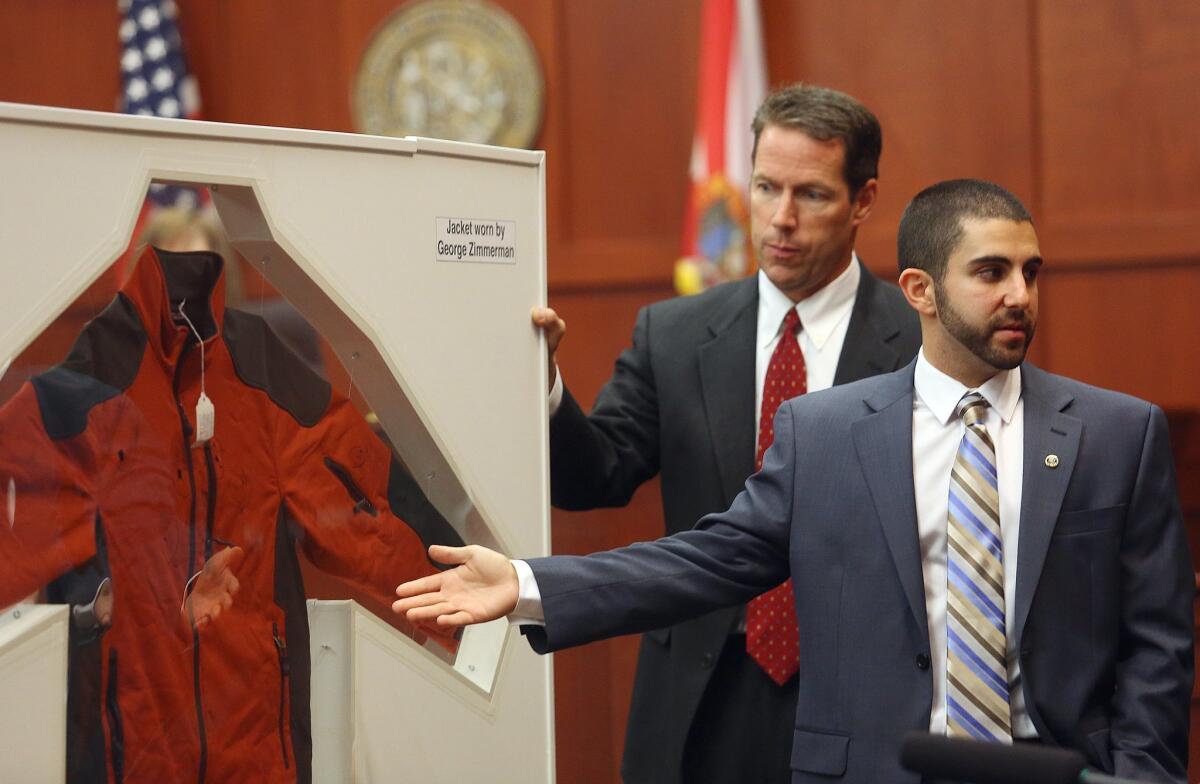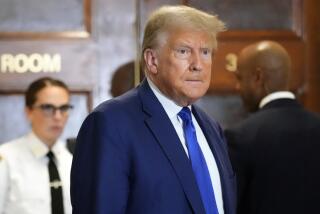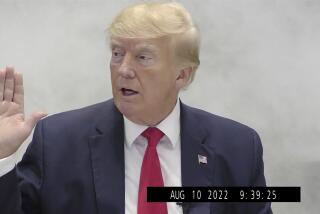Will George Zimmerman take the stand in Florida murder trial?

- Share via
The prosecution is close to ending the presentation of its case against George Zimmerman, giving the defense the chance to play offense in the murder trial. The big question is whether Zimmerman will take the stand to explain how he shot an unarmed teenager, Trayvon Martin, to death.
The prosecution will resume on Friday morning, taking nine days to give its case that Zimmerman, 29, profiled, followed, then fatally shot Martin, 17, in a confrontation on Feb. 26, 2012 in a gated community in Sanford, Fla. Zimmerman, who is charged with second-degree murder, acknowledges that he shot Martin, an African American, but said he acted in self-defense.
Putting Zimmerman on the stand has both advantages and problems — for both sides.
GRAPHIC: Who’s who in the Trayvon Martin case
Zimmerman could come across as a person who is sorry about the confrontation and killing Martin, for whose death he has apologized before. Zimmerman might also explain why he has told different versions of events and give what would become the new, definitive account. But he would also open himself up to a withering cross-examination that could undermine his credibility with the jury.
During its case, the prosecution made the points that it had promised in the opening statements. Witnesses and documents were used to present Zimmerman as a police wannabe, an eager neighborhood watch volunteer who was growing more frustrated by crime in his housing community. He saw Martin, a stranger walking on a rainy night and called authorities to report someone suspicious. The dispatcher advised him to let the police handle it.
In one version of events that Zimmerman told, he was walking in the same direction as Martin when the teenager attacked him, beating him with dozens of blows and battering his head on the ground.
Photographs were admitted showing Zimmerman with a bleeding nose and two lacerations on the back of his head, injuries prosecution witnesses said were minor and insignificant.
The prosecution has argued the limited extent of the wounds makes Zimmerman’s version of events unbelievable. A barrage of blows should have done more damage to Zimmerman and resulted in more blood on Martin’s clothing, the prosecution maintains. None of Zimmerman’s DNA was found underneath Martin’s fingernails and none of Martin’s DNA was found on the gun, a prosecution expert said.
The defense, in its cross-examination, has already questioned those findings. The scene could have been contaminated by the rain that night and the police did not wrap Martin’s hands in plastic. Martin’s wet clothes were stored in plastic, which could have led to degradation and poor test results as well, the defense pointed out.
PHOTOS: The controversial case in pictures
During its strong cross-examinations, the defense was able to use the prosecution witnesses to make its points. Where the prosecution saw Zimmerman as an avenger, the defense in its questioning saw him as a good citizen, making a personal sacrifice to help neighbors stay safe.
Where the prosecution saw Zimmerman as using his knowledge of police procedure and self-defense law to tailor his responses to authorities, the defense saw him as a person trying to better himself by having a career in law enforcement.
The defense disputes that Zimmerman’s wounds were minor, but also argues that the condition is less important than the fear it inspired in Zimmerman. The volunteer had reason to be afraid — the key criteria for self-defense — and reacted accordingly. Such action is within the self-defense law, they indicated in questioning a lawyer who taught Zimmerman about self-defense law in a class.
There are no direct eyewitnesses to the moments before the two faced off, but at least one witness, John Good, one of Zimmerman’s former neighbors, said he saw the pair tussle. Martin in a dark sweatshirt, appeared to be on top of Zimmerman, Good testified. He said he heard cries for help coming from the person on the bottom.
Audio experts said there was no way science could identify whose voice and screams were caught in a 911 call, but Martin’s mother, Sybrina Fulton, is expected to testify that the voice is her son’s. The defense could chose to bring in Zimmerman relatives to make a contrary identification.
The six-person jury, which has been sequestered, will have to wade through the conflicting forensic evidence. But it will also have to try to reconcile the different versions of events that they heard from Zimmerman.
The volunteer was interviewed by police hours after the shooting, and later again by police. On the afternoon of Feb. 27, he walked authorities through the scene, and his statement was recorded on video. All versions were played for the jury, along with recorded calls to dispatchers and selected parts of Zimmerman’s interview with Fox News’ Sean Hannity.
Zimmerman gives substantially the same story in each statement, though the details vary. The defense dismissds the differences, getting witnesses to agree that they were the types of different accounts one could expect from a person who gone through a traumatic experience. The prosecution argued that Zimmerman was embellishing at key points to put himself in a better light to sustain his self-defense argument.
It would take Zimmerman on the stand to reconcile the different versions, but that would open him up to cross-examination by the prosecution. Armed with different statements, the prosecution would be able to question Zimmerman on what he has said in the past and how it differs with his trial testimony.
ALSO:
Man with guns, armor, Molotov cocktails arrested in Seattle
Arizona wildfire: Investigators’ answers will be in the details
Woman saved from sinkhole in Toledo, Ohio, describes rescue
More to Read
Sign up for Essential California
The most important California stories and recommendations in your inbox every morning.
You may occasionally receive promotional content from the Los Angeles Times.











